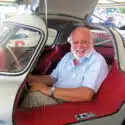Doug Nye: ‘Jenks was an enthusiast observer, eager to share what he had experienced’
A generation of Motor Sport readers saw racing through the eyes of Denis Jenkinson: our legendary continental correspondent
On this magazine’s centenary may I muse upon one half of the editorial duo who built its reputation postwar; ‘W.B.’ – the renowned William ‘Bill’ Boddy – and his sometime friend/rival ‘D.S.J.’ – Denis ‘Jenks’ Jenkinson.
What a remarkably eccentric duo they were. Jenks’s passion for motor sport in all its forms made his lifestyle almost gratuitously irritating to any conventional materialist. He was a jazz-loving bohemian, a beardie-weirdie – content to ‘live up a tree’ in rural Hampshire when not touring the race circuits of Europe.
Jenks’s initials ‘D.S.J.’ – he never used middle name Sargent – graced his writings in Motor Sport for some 40 years. He never considered himself a journalist. He was just an enthusiast observer, eager to share with readers what he had seen and experienced.
From childhood, Jenks determinedly ran his own life his own way. He was a tough little nut, utterly obsessed by motor cars and motor racing. He discovered Motor Sport in 1932, aged 12. He religiously saved tuppence a week to buy the latest issue each month.
He became a great cyclist, riding to spectate at Lewes hillclimb, the Brighton Speed Trials, or later Crystal Palace. Brooklands was out of the question – “Too expensive”. In his teens he became an excellent gymnast. Cycling had packed muscle into his small frame. He cycled everywhere – 220 miles per week – and also became a competitive swimmer, and a prize-winning high-board diver.
With elder brother Harold he spectated at the 1938 Donington GP. Schoolfriend Bob Newton taught him to ride an elderly flat-twin Douglas motorcycle. They saved up to buy tickets for a Brooklands meeting, then Jenks answered a letter in Motor Sport asking for help to run a racing car. It was from Bob Cowell in Croydon and Easter 1939 found Jenks in the Brooklands paddock polishing the Cowell Alta EOY 8. “I never bought a ticket again”.
To him, World War II became a pestiferous squabble between governments which spoiled his fun. Jenks refused absolutely to inflict harm on another human being and registered instead as a conscientious objector. In 1941 he was directed to join the Royal Aircraft Establishment at Farnborough, where his subsequent motorcycling friend Mick Wilkins first knew him “…as the little feller with the big hat and no socks – he swapped the saved clothing coupons for petrol coupons”. He lived cheaply but saved £150 for the down payment on a Frazer Nash, which he would race at Gransden Lodge the moment peace returned.
But the Nash was too expensive. He bought a racing 350cc Norton motorbike instead. Renting a lock-up was cheaper than digs, so home became a sleeping bag in a lock-up. In 1947 he raced the Norton at Dunholme Lodge, Oliver’s Mount and Cadwell Park. He was encouraged to join the Continental motorcycle racing circus. There he linked up with sidecar racer Eric Briggs, then with confirmed sidecar master Eric Oliver. Minimum regulation weight for a passenger was 60kg. Jenks in his kit: 59.9kg. With a spanner in his pocket he was ‘in’.
They built a new Norton sidecar combination for 1949, and won the first FIM Sidecar Racing World Championship title! Many major motorcycle events were combined with races for cars. Diarist Jenks began to sell reports on both sports for Motor Sport, The News Chronicle and Motor Cycling, plus the 500cc F3 magazine Iota.
“May Day had always been special to him since the Mille Miglia win”
From 1950-52 he passengered Belgian sidecar racer Marcel Masuy, preparing the machine and living in Brussels. Then, on March 11, 1953, Motor Sport’s owner Wesley J. Tee offered him full-time employment – paying all Jenks’s expenses, but no wage. Jenks accepted.
That deal sustained him as he continued the gypsy life so enviable for all homebound racing enthusiasts. Notional ‘home’ was a cottage room adjoining The Phoenix pub at Hartley Wintney, Hampshire. From 1953 he rented Stratford Lodge, near Odiham. For the 1954 Mille Miglia he wangled a race-day ride with George Abecassis in his HWM-Jaguar sports car. They retired, but when Stirling Moss wanted a passenger/navigator for the ’55 race – with Mercedes-Benz – he asked Jenks. The outcome was their since legendary win.
In 1961 Jenks bought his long-term home, Rye Common Lodge – no mains drainage, water, electricity nor gas – near Crondall, Hampshire. Several girlfriends enjoyed his little lodge house over the years.
He admired people with inquiring minds. He was always incredibly open to much younger like-minded enthusiasts. Amongst would-be racing writers – almost inevitably his former readers – if he thought you were ‘OK’ he would share info, wise experience and advice. Jenks certainly encouraged me, and such other new boys as Andrew Marriott, Alan Henry, Nigel Roebuck, and many more.
And he knew them all – from Ascari to Fangio, Moss to Clark, Stewart, Lauda, Prost and Ayrton Senna for whom in his declining years he developed an almost schoolboy adoration.
May Day had always been special to him since the Mille Miglia win that day. May 1, 1994 then saw Senna’s death – and Jenks was bereft. Much of his lifelong zest for his adored sport left him then. But only in relative terms. Our friend – and mentor – would still have bled racing lore and for long decades, just like a stick of rock, he obviously had Motor Sport lettered right through him. We miss him still.
Doug Nye is the UK’s leading motor racing historian and has been writing authoritatively about the sport since the 1960s

